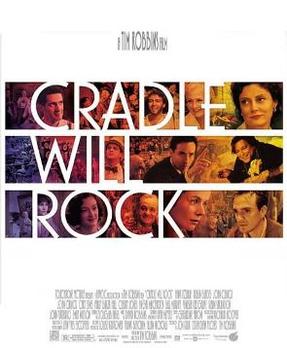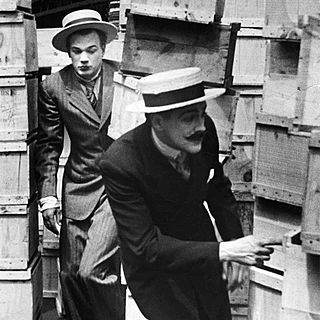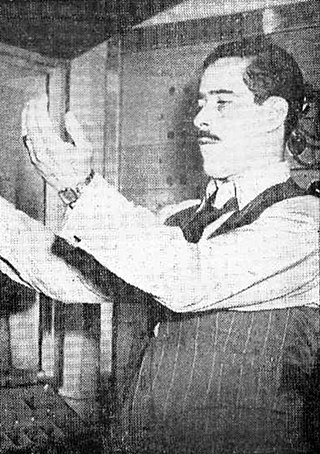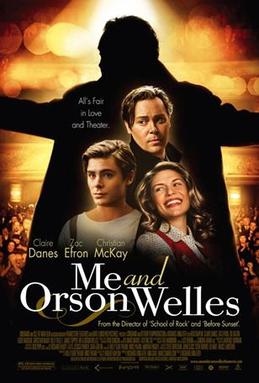Related Research Articles

"The War of the Worlds" was a Halloween episode of the radio series The Mercury Theatre on the Air directed and narrated by Orson Welles as an adaptation of H. G. Wells's novel The War of the Worlds (1898) that was performed and broadcast live at 8 pm ET on October 30, 1938, over the CBS Radio Network. The episode is infamous for inciting a panic by convincing some members of the listening audience that a Martian invasion was taking place, though the scale of panic is disputed, as the program had relatively few listeners.

Trouble in Tahiti is a one-act opera in seven scenes composed by Leonard Bernstein with an English libretto by the composer. It is the darkest among Bernstein's "musicals", and one of only two for which he wrote the words and the music. Trouble in Tahiti received its first performance on 12 June 1952 at Bernstein's Festival of the Creative Arts on the campus of Brandeis University in Waltham, Massachusetts, to an audience of nearly 3,000 people. The NBC Opera Theatre subsequently presented the opera on television in November 1952, a production which marked mezzo-soprano Beverly Wolff's professional debut in the role of Dinah. Wolff later reprised the role in the New York City Opera's first staging of the work in 1958. The original work is about 40 minutes long.

Marcus Samuel Blitzstein, was an American composer, lyricist, and librettist. He won national attention in 1937 when his pro-union musical The Cradle Will Rock, directed by Orson Welles, was shut down by the Works Progress Administration. He is known for The Cradle Will Rock and for his off-Broadway translation/adaptation of The Threepenny Opera by Bertolt Brecht and Kurt Weill. His works also include the opera Regina, an adaptation of Lillian Hellman's play The Little Foxes; the Broadway musical Juno, based on Seán O'Casey's play Juno and the Paycock; and No for an Answer. He completed translation/adaptations of Brecht's and Weill's musical play Rise and Fall of the City of Mahagonny and of Brecht's play Mother Courage and Her Children with music by Paul Dessau. Blitzstein also composed music for films, such as Surf and Seaweed (1931) and The Spanish Earth (1937), and he contributed two songs to the original 1960 production of Hellman's play Toys in the Attic.

Cradle Will Rock is a 1999 American historical drama film written, produced and directed by Tim Robbins. The story fictionalizes the true events that surrounded the development of the 1937 musical The Cradle Will Rock by Marc Blitzstein; it adapts history to create an account of the original production, bringing in other stories of the time to produce a social commentary on the role of art and power in the 1930s, particularly amidst the struggles of the labor movement at the time and the corresponding appeal of socialism and communism among many intellectuals, artists and working-class people in the same period.

The Mercury Theatre was an independent repertory theatre company founded in New York City in 1937 by Orson Welles and producer John Houseman. The company produced theatrical presentations, radio programs and motion pictures. The Mercury also released promptbooks and phonographic recordings of four Shakespeare works for use in schools.

The Cradle Will Rock is a 1937 play in music by Marc Blitzstein. Originally a part of the Federal Theatre Project, it was directed by Orson Welles and produced by John Houseman. Set in Steeltown, U.S.A., the Brechtian allegory of corruption and corporate greed includes a panoply of social figures. It follows the efforts of Larry Foreman to unionize the town's workers and combat the powerful industrialist Mr. Mister, who controls the town's factory, press, church, and social organization. The piece is almost entirely sung-through, giving it many operatic qualities, although Blitzstein included popular song styles of the time.

Martin Gabel was an American actor, film director and film producer.

Too Much Johnson is a 1938 American silent comedy film written and directed by Orson Welles. An unfinished film component of a stage production, it was made three years before Welles directed Citizen Kane, but it was never publicly screened. It was shot to be integrated into Welles's Mercury Theatre stage presentation of William Gillette's 1894 comedy, but the film sequences could not be shown due to the absence of projection facilities at the venue, the Stony Creek Theatre in Connecticut. The resulting plot confusion reportedly contributed to the stage production's failure.

The Spanish Earth is a 1937 anti-fascist film made during the Spanish Civil War in support of the democratically elected Republicans, whose forces included a wide range from the political left like communists, socialists, anarchists, to moderates like centrists, and liberalist elements. The film was directed by Joris Ivens, written by John Dos Passos and Ernest Hemingway, narrated by Orson Welles and re-recorded by Hemingway, with music composed by Marc Blitzstein and arranged by Virgil Thomson.
Pins and Needles (1937) is a musical revue with a book by Arthur Arent, Marc Blitzstein, Emmanuel Eisenberg, Charles Friedman, David Gregory, Joseph Schrank, Arnold B. Horwitt, John Latouche, and Harold Rome, and music and lyrics by Rome. The title Pins and Needles was created by Max Danish, long-time editor of the International Ladies Garment Workers Union (ILGWU)'s newspaper Justice.

Columbia Workshop was a radio series that aired on the Columbia Broadcasting System from 1936 to 1943, returning in 1946–47.
The Airborne Symphony is a work by American composer Marc Blitzstein for narrator, vocal soloists, male chorus, and large orchestra that premiered April 1–2, 1946. A history of human flight, the symphony uses music that the United States Army Air Forces, in which Blitzstein served during the World War II, originally commissioned for use in film.

Me and Orson Welles is a 2008 period drama film directed by Richard Linklater and starring Zac Efron, Christian McKay, and Claire Danes. Based on Robert Kaplow's novel of the same name, the story, set in 1937 New York, tells of a teenager hired to perform in Orson Welles's groundbreaking stage adaptation of William Shakespeare's Julius Caesar who becomes attracted to a career-driven production assistant.
Reuben, Reuben is a two-act, "urban folk opera" by Marc Blitzstein, written from 1953 to 1955. Set in New York's Little Italy and inspired by the Faust legend, it concerns Reuben, a suicidal veteran who has received a medical discharge because he cannot speak. His disorder serves as an allegory of the difficulties of interpersonal communication in society, and of the eventual triumph of love over these difficulties and over the death wish. It was shown at the Shubert Theatre in Boston from October 10 to 22, 1955. Hanya Holm choreographed, Robert Lewis stage directed, and Cheryl Crawford produced the show.
The Second Hurricane is an opera in two acts by Aaron Copland to a libretto by Edwin Denby. Specifically written for school performances, it lasts just under an hour and premiered on April 21, 1937, at the Henry Street Settlement playhouse in New York City. Set in the United States in the 1930s, the opera tells the story of a group of high school students who become trapped on an island while working to rescue the victims of a hurricane.

The 48th Street Theatre was a Broadway theatre at 157 West 48th Street in Manhattan. It was built by longtime Broadway producer William A. Brady and designed by architect William Albert Swasey. The venue was also called the Equity 48th Street Theatre (1922–25) and the Windsor Theatre (1937–43).

This is a comprehensive listing of the theatre work of Orson Welles.
There isn't one person, I suppose, in a million, who knows that I was ever in the theatre.
The Comedy Theatre was a Broadway theatre located at 110 West 41st Street in Manhattan that opened in 1909. It presented the first Broadway appearances of Katharine Cornell and Ruth Draper, as well as Eugene O'Neill's first Broadway play. Shuttered in the wake of the Depression, it reopened in 1937 as the Mercury Theatre – the venue for Orson Welles's groundbreaking adaptation of Shakespeare's Julius Caesar and other productions for the Mercury Theatre repertory company. In 1939 it began presenting classic Yiddish theatre. The building was demolished in 1942.

Caesar is the title of Orson Welles's innovative 1937 adaptation of William Shakespeare's Julius Caesar, a modern-dress bare-stage production that evoked comparison to contemporary Fascist Italy and Nazi Germany. Considered Welles's highest achievement in the theatre, it premiered November 11, 1937, as the first production of the Mercury Theatre, an independent repertory theatre company that presented an acclaimed series of productions on Broadway through 1941.
Tales of Malamud is the name of two, one-act operas by Marc Blitzstein based on two stories by American writer Bernard Malamud. Namely, “Idiots First” and “The Magic Barrel.” At the time of his death in 1964, Blitzen had yet to formally finish both of the operas. The project was completed by American composer Leonard Lehrman and subsequently premiered in March 1977 in Bloomington, Indiana.
References
- Pollack, Howard (2012), Marc Blitzstein: His Life, His Work, His World, New York: Oxford University Press, doi:10.1093/acprof:oso/9780199791590.001.0001, ISBN 9780199791590
- ↑ Pollack 2012, p. 196.
- 1 2 3 Pollack 2012, p. 199.
- ↑ "I've Got the Tune". The Marc Blitzstein Web Site. Retrieved 2015-09-06.
- 1 2 3 Welles, Orson; Rosenbaum, Jonathan (afterword) (1994). Pepper, James (ed.). The Cradle Will Rock: An Original Screenplay. Santa Barbara, California: Santa Teresa Press. ISBN 0-944166-06-7.
- ↑ Robert J. Dietz, "Marc Blitzstein and the "Agit-Prop" Theatre of the 1930s," Anuario Interamericano de Investigacion Musical, vol. 6 (1970), p. 65. (JSTOR access by subscription)
- ↑ Pollack 2012, p. 200-201.
- 1 2 3 4 5 6 Pollack 2012, p. 201.
- ↑ Robert J. Dietz, "Marc Blitzstein and the "Agit-Prop" Theatre of the 1930s," Anuario Interamericano de Investigacion Musical, vol. 6 (1970), p. 64. (JSTOR access by subscription)
- 1 2 3 Pollack 2012, p. 202.
- ↑ Robert Reinhart, "Drama in Control Room Overshadows Irving Reis' CBS Lads and Lassies," Variety (October 27, 1937), 38.
- ↑ Lloyd, Norman (1993) [1990]. Stages of Life in Theatre, Film and Television. New York: Limelight Editions. ISBN 9780879101664.
- 1 2 3 Pollack 2012, p. 204.
- 1 2 "Dramatizing Air Show," Variety (March 23, 1938), p. 58.
- 1 2 3 Lehrman, Leonard (2005). Marc Blitzstein: A Bio-bibliography. Westport, Connecticut: Praeger. ISBN 9780313300271.
- ↑ "'Plant in Sun' Repeated … Also 'I've Got the Tune'". The New York Times. February 21, 1938. Retrieved 2015-09-08.
- ↑ "New Theatre League," Variety (February 23, 1938), p. 58.
- ↑ Pollack 2012, p. 198.